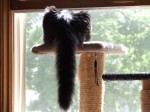 From a genetic viewpoint, the modern housecat is virtually indistinguishable from F. s. lybica, the subspecies of wildcat called the African Wild Cat, that hails from the Middle Eastern deserts of Israel, the United Arab Emirates and Saudi Arabia, and well as parts of Africa. Although the African wild cat still exists to this day, mitochondrial genetic analyses indicates that our beloved housemates are likely descended from only five female cats taken from that region approximately 10,000 years ago. (Full study: The Near Eastern Origin of Cat Domestication. Summary: The Evolution of House Cats.)
From a genetic viewpoint, the modern housecat is virtually indistinguishable from F. s. lybica, the subspecies of wildcat called the African Wild Cat, that hails from the Middle Eastern deserts of Israel, the United Arab Emirates and Saudi Arabia, and well as parts of Africa. Although the African wild cat still exists to this day, mitochondrial genetic analyses indicates that our beloved housemates are likely descended from only five female cats taken from that region approximately 10,000 years ago. (Full study: The Near Eastern Origin of Cat Domestication. Summary: The Evolution of House Cats.)
Today, there are 42 breeds of cats recognized by the Cat Fanciers Association (55 by the International Cat Association), although most cat owners enjoy the companionship of non-breed-specific cats, often referred to as moggies. It’s believed that 16 of the recognized breeds are “natural breeds” that emerged in specific regions, while the remaining were developed within the last 50 or so years.
Two relatively new breeds attracting lots of attention are the Bengal and the Savannah cats. Bengals were originally produced by crossing the Asian Leopard Cat to a domestic cat such as the Abyssinan, American Shorthair, Burmese, or Egyptian Mau, while Savannahs are a cross between the African Serval and Oriental Shorthairs, Egyptian Maus, Serengetis, and even Bengals.

